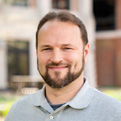Faculty & Staff

Dr. B. Daniel Pierce
-
Profile
Tumors in plants are often caused by the pathogenic soil bacterium, Rhizobium radiobacter (formerly Agrobacterium tumefaciens). To cause these tumors, R. radiobacter transfers oncogenic DNA into its host plant, where it is integrated into the genome and expressed. This process is unique, as it is the only known instance of regular inter-kingdom gene transfer, and continues to be used by countless plant scientists for creating transgenic plants. Our lab seeks to understand how these bacteria commit to this process, starting with the reception of signals released by a wounded plant and resulting in a molecular signaling cascade that leads to the expression of virulence genes in the bacteria. Additionally, through engineering R. radiobacter as fluorescent probes, we are creating spatio-temporal maps of the signaling landscape using various host plants. Through the use of botanical, fluorescence microscopy, and molecular biology tools, we study this mechanism to uncover how bacteria evolved these pathogenic strategies.
Expand All-
Awards
2012-2014: FIRST Institutional Research and Academic Career Development Award (K12) (IRACDA), NIH-funded award to fellows who have a desire to perform research and develop their teaching abilities.
-
Presentations
B. Daniel Pierce, Yue Liu, and David Lynn. Exploring the Signal Landscape of Plants at Wounding Sites. Gordon Research Conference on Plant Volatiles. Ventura, CA. January 25-31, 2014.
B. Daniel Pierce, Yue Liu, Alexandra Fuller, Phoebe Young, and David Lynn. Understanding Plant Signaling Through Use of Agrobacterium tumefaciens and thePlant Parasite, Striga asiatica. IRACDA Conference. Atlanta, GA. June 2-4, 2013.
B. Daniel Pierce and Beverly Wendland. Analysis of the Phospho-Dependent Conformations of the Endocytic Scaffold Pan1. American Society for Cell Biology Annual Meeting. Philadelphia, PA. December 11 – 15, 2010.
B. Daniel Pierce and Beverly Wendland. Intrinsically disordered regions of the essential yeast endocytic scaffold Pan1 may contribute to regulation of endocytosis. Gordon Research Conference on Intrinsically Disordered Proteins. Davidson, NC. July 11 – 16, 2010.
-
Awards
-
Publications
Journal Articles
Fang F, Lin Y-H, Pierce BD, Lynn D. A Rhizobium radiobacter histidine kinase can employ both Boolean AND and OR gates for initiating pathogenesis. ChemBioChem. 2015 Oct; 16(15): 2183-90.
Lin Y-H, Pierce BD, Fang F, Wise A, Binns A, Lynn D. Role of the VirA histidine autokinase of Agrobacterium tumefaciens in the initial steps of pathogenesis. Frontiers in Plant Science. 2014. doi: 10.3389/fpls.2014.00195
Pierce BD, Toptygin, D, Wendland B. Pan1 is an intrinsically disordered protein withhomotypic interactions. Proteins. 2013 Nov; 81(11): 1944-63.